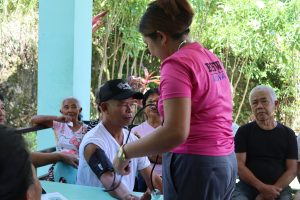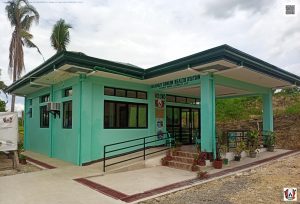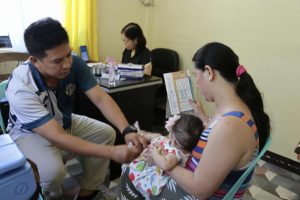Ignacia Pagtulombon, 65, waits calmly for her turn to be checked on a serene Friday morning. She is one of over 100 residents of Barangay Bonbon, in Aloguinsan, western Cebu, who lined up to have their blood pressure monitored and receive medicine from the barangay health station.

The scene at Bonbon Health Station that day defied expectations for a public facility—especially in the municipality’s largest barangay with a population of over 10,000.
Though its rural setting adds to the calm, the orderly atmosphere is primarily a result of the well-maintained facility, now safely relocated a few meters from its former roadside location and roughly three times larger.
“Mas okay kaayo karon diri kaysa didto sa ubos kay ang health center didto gamay ra ba. Diri karon, naa na halos tanan. Iya-iya sila og kwarto. Mas hawan (It’s much better here now compared to the one below, which was small. Here, almost everything is available. Each service has its own room and is spacious),” she said.
The over P5 million health center, a subproject under KALAHI-CIDSS NCDDP Additional Financing Phase 1, was built through the community’s collective effort after being identified as a top priority, replacing the former center affected by a road widening project.
Three years after it became operational in 2022, the health center continues to serve the underserved in Barangay Bonbon. It not only proves the effectiveness of the sustainability evaluation tool institutionalized by KALAHI-CIDSS but also shows how much the community values what they consider a treasure.
Over time, it has expanded its services to effectively address the increasing needs of the community. It now offers pre-natal checkups, blood pressure monitoring, first aid, child immunization, and circumcision. It also occasionally hosts bloodletting drives, feeding programs, and 4Ps health monitoring.
Barangay Councilor Owen Manguilimotan, who was the barangay captain during the implementation of the KALAHI-CIDSS subproject, said several maintenance efforts have already been conducted and are pipelined for their health station.
In recent years, the barangay has committed to sustaining its health station by allocating funds for repairs and upkeep, including P25,000 for utilities and minor fixes, and P50,000 for repainting. Plans for a perimeter fence are also underway, spurred by the consistent follow-up from residents and staff.
Led by midwife Ana Mercedes Manguilimotan, the station is staffed daily by six of its 32 barangay health workers.
“Ma-trabaho jud na siya kay sige man pod sila og pangulit (It will get done because the residents and workers keep following upo),” Councilor Manguilimotan said.
Pre-natal services are offered during the first week of each month, while family planning is available daily. Child immunization is scheduled every third and last Friday of the month.

Ana Chuchie Adolfo, a barangay nutrition scholar, said they ensure that their services adapt to the needs of the community.
Adolfo said: “Now that we have more equipment, we’ve been able to expand our services.”
Some BHWs candidly shared that some residents donated used yet still functional wheelchair and nebulizer for the center.
Prioritization
Councilor Manguilimotan shared that the health center was one of three priority projects– alongside street lighting and toilet bowls– identified before KALAHI-CIDSS intervened. Through participatory planning, residents chose to prioritize the center due to a road project that would affect the old facility and its limited capacity.
“With so many residents, people used to wait by the roadside. The new health center is essential so they no longer need to travel far,” he said.
To sustain it, the barangay doubled its maintenance medicine budget from P200,000 to P400,000 and plans to allocate 5% of its funds for senior citizens and PWDs to medical assistance.
The community finished the health station officially the “COVID-19 Response Through Construction of Barangay Health Station with Amenities, Medical and Disinfectant Tools, Equipment and Supplies” subproject of KALAHI-CIDSS in Central Visayas on March 24, 2022.
The total construction cost for the health station was P5,582,200, with P4,421,300 funded by the KALAHI grant and P1,160,900 provided as the local counterpart.
The project received Excellent and Very Satisfactory ratings in evaluations by KALAHI-CIDSS RPMO 7 on September 7, 2022; October 3, 2023; and September 25, 2024. It was also rated Excellent in organization and management, institutional linkage, finance, and technical aspects.
More than just the physical legacy, KALAHI-CIDSS’ community-driven development (CDD) approach lives on in the heart of volunteers.
Ana Chuchie fondly shared how she developed her communication skills while attending several seminars with KALAHI-CIDSS.

“From answering questions to speaking on stage in front of a crowd, people even joked that I might run for councilor because of how well I spoke about the KALAHI-CIDSS project,” she said in Cebuano.
“It’s true that since I joined KALAHI, I’ve learned a lot,” she added, noting how she learned a thing or two about the procurement process of the government when she was involved in canvassing for supplies and materials for their health station.
The project’s success lies not just in the continued operation of the facility and the number of patients it serves each day, but most importantly in how it fosters community cooperation and empowers the people of Bonbon to take charge of their own development.
While KALAHI-CIDSS provided guidance, it was ultimately the community—guided by the principles of Community-Driven Development—that led the way. ###